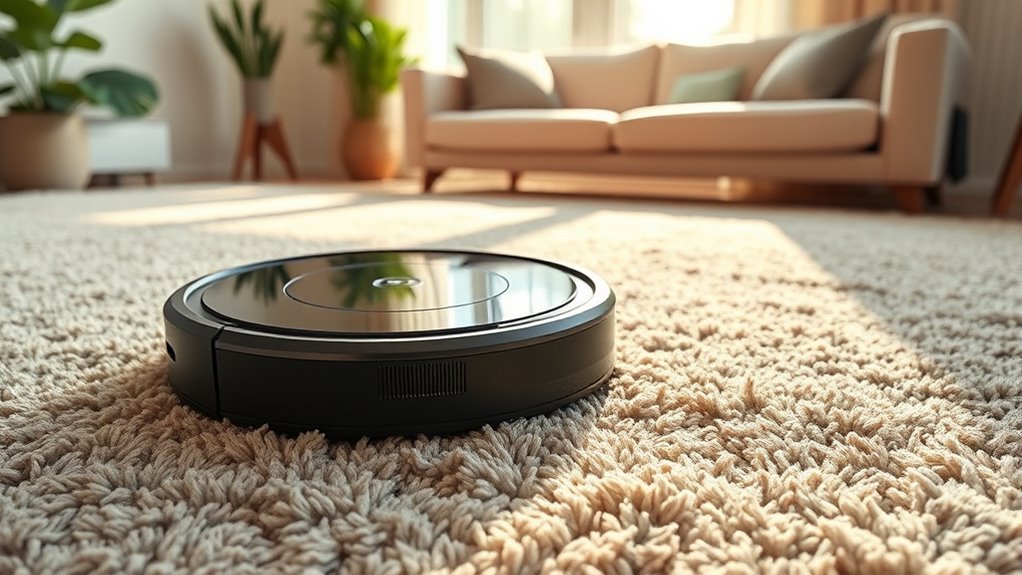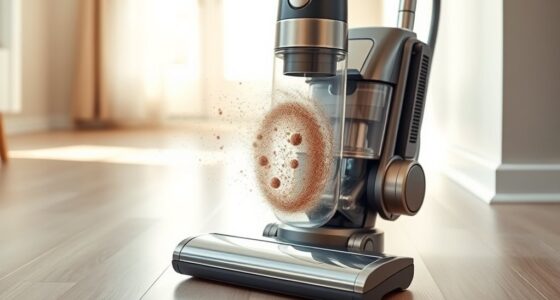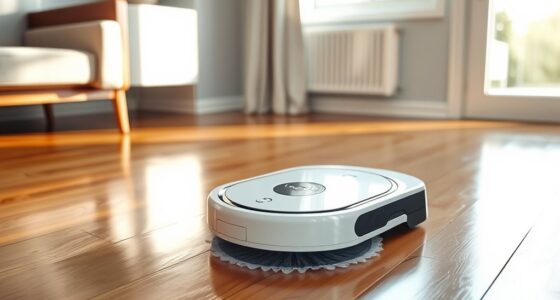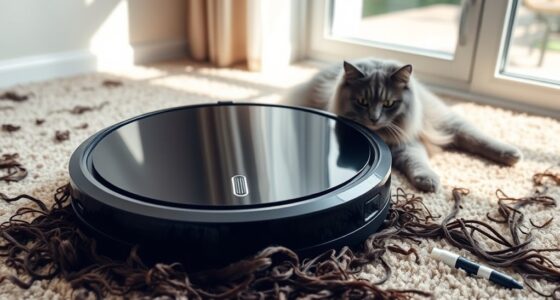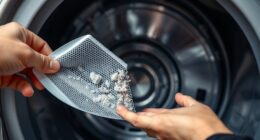To get your robot vacuum to clean thick carpets effectively, you should perform regular maintenance like cleaning brushes, filters, and sensors, and inspecting wheels for debris. Adjust its settings to high-power or boost mode for better suction, and schedule multiple passes to ensure deep dirt removal. Pre-clean with a traditional vacuum and clear obstacles to improve navigation. Mastering these tips will help your robot tackle dense carpets efficiently—learn more ways to optimize its performance now.
Key Takeaways
- Regularly clean brushes, filters, and sensors to optimize robot vacuum performance on thick carpets.
- Use high-power or boost modes and schedule multiple passes for thorough cleaning of dense surfaces.
- Pre-clean with a traditional vacuum to remove deep debris before robot cleaning; clear obstacles for better navigation.
- Check and maintain wheels and brushes to prevent mobility issues caused by debris buildup.
- Adjust cleaning settings based on carpet pile height to maximize suction and efficiency.
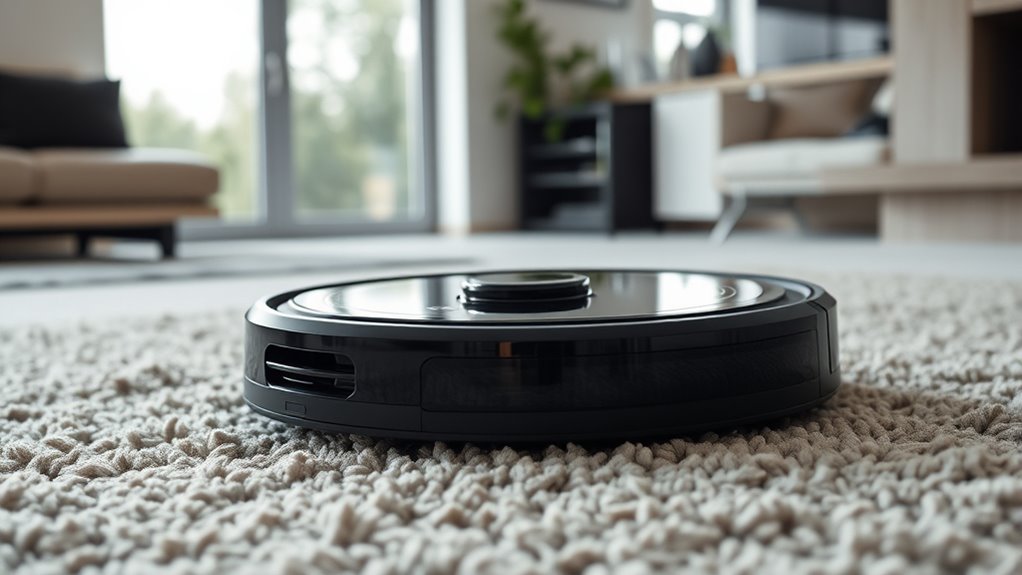
Robot vacuums have become popular for their convenience, but thick carpets can pose challenges for many models. If you want your robot to keep your home spotless on these dense surfaces, understanding how to maintain your device and optimize its cleaning performance is vital. Proper robot vacuum maintenance involves regular inspection, cleaning of brushes and filters, and ensuring sensors stay dust-free. When working on thick carpets, these steps become even more essential because debris tends to get trapped more easily, and a well-maintained vacuum performs more efficiently.
Regular maintenance boosts robot vacuum performance on thick carpets.
One of the first thick carpet cleaning tips is to check and clean the brushes frequently. Hair, fibers, and dust often wrap around the brush rollers, reducing their effectiveness. Removing debris from these parts not only improves suction but also prevents motor strain, which can lead to early wear. Additionally, filters should be cleaned or replaced as recommended by the manufacturer—clogged filters hinder airflow, making it harder for the vacuum to pick up dirt on dense carpets. Keeping sensors clean is equally important; dust on sensors can cause the robot to misjudge obstacles or fall off edges, which is especially problematic on thick, plush surfaces. Regular maintenance also includes inspecting the wheels for debris and ensuring they turn freely to maintain optimal mobility.
Another vital aspect is adjusting your robot vacuum’s settings or modes to better handle thick carpets. Many models come with carpet boost or high-power modes—use these to increase suction for better dirt pickup. However, be mindful that running these modes continuously can drain the battery faster, so it’s wise to use them selectively. When cleaning thick carpets, it’s also helpful to schedule multiple passes or increase the cleaning frequency to prevent debris buildup. Regular maintenance combined with strategic cleaning ensures your robot remains effective over time.
You should also consider the placement of your furniture and the layout of your home. Thick carpets can hide dirt deep within the fibers, so pre-cleaning by hand or using a traditional vacuum for initial cleanup can make your robot’s job easier. Additionally, clearing obstacles and loose items from the floor helps your robot navigate smoothly, preventing it from getting stuck or missing sections of the carpet. Keep in mind that some robot vacuums have limitations with certain pile heights; checking your model’s specifications can help you understand its capabilities and avoid frustration. Being aware of the dust accumulation tendencies on plush surfaces can help you plan more effective cleaning routines to maintain a spotless home.
Frequently Asked Questions
Can Robot Vacuums Clean Pet Hair Effectively on Thick Carpets?
You wonder if robot vacuums can effectively handle pet hair on thick carpets. The truth is, many models excel at pet hair removal and provide decent carpet deep cleaning. Look for robots with strong suction, high-quality brushes, and advanced filtration. Regular maintenance keeps them performing well. While they may not replace deep cleaning, they’re great for daily upkeep and managing pet hair on thick carpets.
How Often Should I Replace the Filters on My Robot Vacuum?
Think of your filter as the lungs of your robot vacuum; it needs fresh breath to perform well. You should check and replace the filter every 2-3 months, or sooner if you notice reduced suction or increased dust. Regular filter maintenance keeps your vacuum breathing easy, ensuring peak cleaning. By following the recommended replacement frequency, you prolong your device’s lifespan and maintain its efficiency effortlessly.
Are There Specific Brands Better Suited for Thick Carpet Cleaning?
You should look for brands known for their compatibility with thick carpets, ensuring better cleaning efficiency. Brands like Roomba, Shark, and Eufy often offer models designed specifically for dense carpets, providing stronger suction and better brush systems. Check each brand’s compatibility with thick carpet cleaning, and choose a model that emphasizes deep cleaning features. This way, you’ll get the most effective cleaning results on your carpets.
Do Robot Vacuums Damage Delicate or Vintage Thick Carpets?
Think of your vintage thick carpet as a delicate relic, fragile yet treasured. You might worry that robot vacuums, with their powerful vacuum suction, could cause damage. Rest assured, if you choose a model with gentle suction settings and prioritize carpet durability, it’s unlikely to harm your cherished rug. Just like a careful hand, a good robot vacuum can clean without compromising the vintage charm you love.
How Do Robot Vacuums Handle Rugs With High Pile or Shaggy Textures?
You might wonder how robot vacuums handle rugs with high pile or shaggy textures. Due to robot vacuum limitations, they can struggle with rug pile challenges, especially on thick or shaggy carpets. The brushes may get tangled, and suction might be less effective. To guarantee good cleaning, choose models with adjustable height or specialized brushes designed for high-pile rugs, and always check manufacturer guidelines to avoid damage.
Conclusion
Imagine trying to sweep through a dense jungle with a tiny broom—that’s what cleaning thick carpets with a basic robot vacuum feels like. But with the right model, you can glide effortlessly, just like a skilled explorer charting new terrain. According to industry data, high-powered robot vacuums improve cleaning efficiency on thick carpets by up to 30%. Invest in the right one, and you’ll find cleaning becomes less of a chore and more of a smooth adventure.
